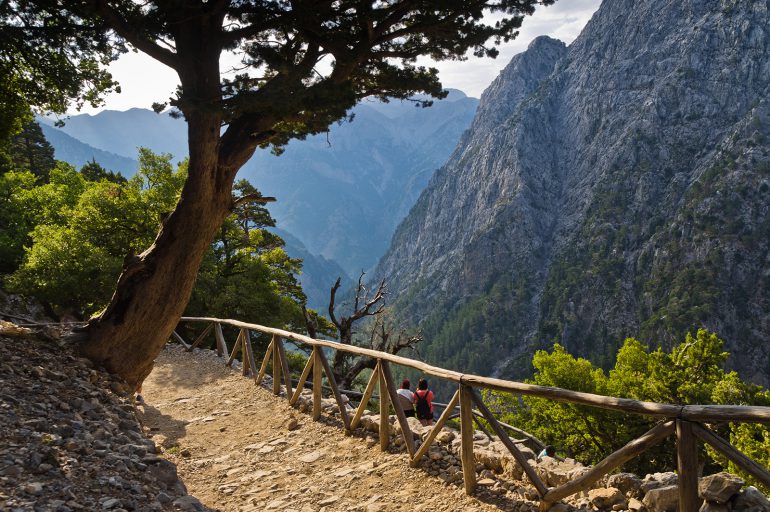For keen hikers and nature-lovers, no destination in Crete is more popular than the Samaria Gorge. Tens of thousands of visitors head to Chania province to walk this world-famous ravine each year, and in July and August a thousand people a day file down the 12.8 km route.
The starting point is Xyloskalo, more than 1200 meters above sea level on the Omalos Plain. This is the northern entrance to the National Park of Samaria and having paid the €5 entrance fee, your adventure begins. The national park is an area of pristine natural beauty, with a deep and fascinating history, and taking this path, you’re treading in ancient footsteps. The descent into the gorge is probably the most physically demanding section, with its steep stone path taking its toll on the knees, but a handrail helps. Many of the accidents that occur in the gorge happen on this two-kilometer stretch, so take care.
It’s important to pause regularly, and take a sip or two of water when you do. The first designated resting spot, with a freshwater spring, is Neroutsiko 1.7 km from the start. You’ve pretty much reached the bottom of the valley by now and soon you’ll begin to crisscross the riverbed. The river, not much more than a stream in summer, is known as the Tarraios, which was named after the ancient city of Tarra – today called Agia Roumeli – your destination.
Through Agios Nikolaos, which has water and toilets, the next resting point, and the most popular, is the abandoned village of Samaria. This is the half-way point along the gorge. First settled in Byzantine times, Samaria was continuously inhabited until 1962, when the National Park was created and the last villagers relocated. For hundreds of years Samarians relied on logging the nearby cypress forest and exporting the timber from Agia Roumeli.
Keep a look-out for the wild goats at Samaria. Known as Kri-Kri (Capra aegagrus cretica), Cretans also call them Agrimia (the wild ones). Unique to Crete, the horned Kri-Kri are unique to Crete, and are seen as a symbol of the untamed Cretan spirit.
Once on the path out of Samaria, you may have completed half the walk, but’s it’s only now you’re at the true beginning of the gorge, with its towering cliffs above you. It’s important to heed the warning about falling rocks; it’s a real threat. Recrossing the river on stones and makeshift bridges, it will take an hour or more to traverse this most dramatic part of the walk.
At the 11km mark take a rest at the shaded clearing known as Christos; it’s also the last spring to refill your water. A little further on is the gorge’s most photographed section – ‘the Gates’ – the narrowest point, where the gorge’s width is are just four meters. As you pass through this almost timeless portal, it’s humbling to think of those, who across hundreds and thousands of years, have passed this way before.
After another 2km you’ll have left the National Park. You have walked Samaria. But there’s another 3km until you get to Agia Roumeli and some well-deserved refreshment. A cold beer has never tasted so good!
The National Park of Samaria is open in the spring, summer and autumn from 7am -to 3pm daily. The whole walk from the entrance to the national park to the village of Agia Roumeli is 16 km, which includes the last leg of 3km beyond the gorge. The entire walk should take 5 to 6 hours, plus rest times. Infrequent hikers should prepare themselves for intense muscle stiffness the day after the walk. So, plan to take it easy!
For up to the minute information on the state of the gorge and weather conditions, call the National Park of Samaria office in Chania, 28210 45570.To walk the Samaria Gorge, it’s best to start early in the morning, so an overnight in Chania or nearby is recommended. A taxi from Chania to Xyloskalo will take just over an hour.
Public KTEL buses depart Chania Bus Station to Omalos and Xyloskalo daily at 07:45, and Mon – Sat at 05:00. Fare €7.50: From Paleochora buses depart at 06:15 on Tues/Sat/Sun (€7).
Getting back
The Anendyk ferry departs Agia Roumeli at 17:30 and arrives Chora Sfakion an hour later (Fare: €12). The ferry for Paleochora from Agia Roumeli (€17) also departs at 17:30. KTEL buses run from Chora Sfakion and Paleochora back to Chania.



